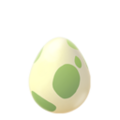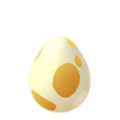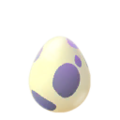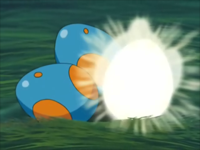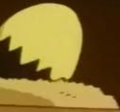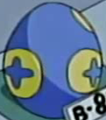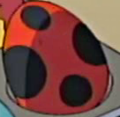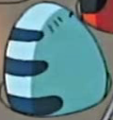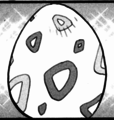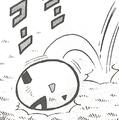Pokémon Egg: Difference between revisions
(→Pokémon Channel: added Phanpy egg) |
|||
| Line 191: | Line 191: | ||
====Pokémon Channel==== | ====Pokémon Channel==== | ||
{{incomplete|section|images of the following Eggs: Azurill | {{incomplete|section|images of the following Eggs: Azurill, Smoochum, Sentret, and Wynaut}} | ||
In {{g|Channel}}, Pokémon Eggs appear on the ''Eggzamination: Hatch Up!'' channel, where the player can guess which Pokémon is within an Egg, and will win money if correct on hatching, which can take any time between 5 minutes to 24 hours. While some Pokémon hatch from plain white Eggs, a number of Eggs that have appeared in the anime are a main feature on the channel. | In {{g|Channel}}, Pokémon Eggs appear on the ''Eggzamination: Hatch Up!'' channel, where the player can guess which Pokémon is within an Egg, and will win money if correct on hatching, which can take any time between 5 minutes to 24 hours. While some Pokémon hatch from plain white Eggs, a number of Eggs that have appeared in the anime are a main feature on the channel. | ||
| Line 217: | Line 217: | ||
File:Aipom Egg Channel.png|Aipom Egg | File:Aipom Egg Channel.png|Aipom Egg | ||
File:Pichu Egg Channel.png|Pichu Egg | File:Pichu Egg Channel.png|Pichu Egg | ||
File:Phanpy Egg Channel.png|Phanpy Egg | |||
</gallery> | </gallery> | ||
Revision as of 11:57, 27 March 2017

A Pokémon Egg (Japanese: ポケモンのタマゴ Pokémon Egg) is an object from which most Pokémon are known to hatch. An Egg's shell will usually have a pattern that reflects the appearance of the Pokémon developing inside, though in the games, this is not the case.
Pokémon Eggs are produced by breeding two Pokémon of a compatible Egg Group and opposite gender together and will contain, by default, the lowest species in the evolutionary line of the mother. According to a girl in Solaceon Town, where one of many Pokémon Day Cares are located, no one has ever seen a Pokémon lay an Egg, and thus, it is not confirmed that this is how they appear. According to a Monsieur in Coumarine City, Eggs are not actually eggs and are more like "cradles".
Some Pokémon, known as baby Pokémon, are also found by hatching them from an Egg created by their evolved forms, either naturally or through use of a held incense. Unlike other species which cannot breed, baby Pokémon evolve into species which can do so. In the games, Legendary Pokémon cannot breed in captivity, and only two Mythical Pokémon—Manaphy and Phione—are capable of breeding, both producing Phione Eggs when bred with Ditto.
In the games
Pokémon Eggs have appeared in all games where Pokémon breeding has been available, and were a major plot point in Generation II, in which they were introduced. They have also appeared in several side games.
Mechanics

The amount of time left until a Pokémon hatches from its Egg is determined by the number of Egg cycles (which are measured in steps) that the player walks when it is in the party (including movement on a Bicycle or while Surfing). In-game time has no direct bearing on Egg hatching.
Eggs utilize the same memory allocation as Pokémon, so the coding structure is very similar. What would be the friendship value in a Pokémon is the Egg cycle count for an Egg. Unlike friendship, this value counts down at the end of every Egg cycle.
Since Generation V, an Egg will hatch when its Egg cycle count reaches zero. If multiple Eggs become ready to hatch at the same time, the first Egg in the party will hatch first while each subsequent Egg will hatch with each subsequent step.
In Generations III and IV, an Egg will only hatch if its Egg cycle count is zero before an Egg cycle ends (meaning that an extra Egg cycle must be walked). Only one Egg can hatch per Egg cycle, since Eggs are processed in order and if one hatches, any remaining Eggs are not touched.
Generation II is like Generations III and IV except that an Egg will hatch when its Egg cycle count reaches zero.
The number of Egg cycles that an Egg has left determines the text that is shown on its status screen.
Generation II

Generation II introduced the system of Egg creation and hatching that would continue, much unaltered, to the present. The first Pokémon Egg obtainable by the player in the series was a Key Item given by Mr. Pokémon in Pokémon Gold, Silver, and Crystal. The Mystery Egg is to be delivered to Professor Elm in New Bark Town; he will then study it and have one of his aides return it to the player in the Violet City Pokémon Center.
Elm's studies show that when a Pokémon Egg is carried with a Trainer with a party of lively Pokémon, it will eventually hatch. This is easily proven, as some time after the Egg is given, if it is kept in the party, it will hatch into a Togepi.
The player reaching the Daycare on Route 34 marks where the game mechanics of breeding are truly introduced. Though unrevealed in the games (and only ever truly shown by Pokémon Stadium 2 and Pokédex 3D), Pokémon belong to one or two of fifteen Egg Groups, and those which share an Egg Group and are of opposite gender are capable of breeding. Pokémon without gender can be bred with a Ditto, as can any other Pokémon not in the Undiscovered Group. Pokémon in the Undiscovered Group will not breed with any Pokémon or produce any Eggs.
Pokémon that hatch from an Egg will come out at level 5, having whatever moves their species can learn by that level, any move both parents know that the hatched Pokémon can learn through level-up, any TM or HM moves they are compatible with that were known by their father, and any Egg Moves their father passed down. The father's moves take priority over the moves the species would usually have at that level.
These are the only games in which an Egg's status screen differs considerably from that of a normal Pokémon, as all later games use either a modified version of the Pokémon status screen of that game (as is the case in Generation III), or the same status screen, minus some pages (as is the case in Generation IV and V).
Eggs available
Aside from Eggs made by the player's Pokémon, the following Eggs can be obtained in Generation II:
- TogepiGSC: From Mr. Pokémon, initially classed as a Key Item. Received from Professor Elm's aide in Violet City.
- Odd EggC: From the Day-Care Man. Will hatch into a Pichu, Cleffa, Igglybuff, Tyrogue, Smoochum, Elekid, or Magby that knows Dizzy Punch. It has a 14% chance of being Shiny in international versions. In the Japanese version of Crystal, the Day-Care Man instead gives out an Egg Ticket that can be traded in at the Pokémon Communication Center for the Odd Egg. The Odd Egg in the Japanese version has a 50% chance of being Shiny.
Generation III
Generation III retained much of the system introduced in Generation II, with only one major change: incenses are introduced that, if held by the appropriate Pokémon, will cause them to produce Eggs that hatch into new baby Pokémon (who were introduced in this generation). There are incenses for Marill's and Wobbuffet's evolutionary lines, which allow them to produce Eggs that hatch into Azurill and Wynaut respectively. Presumably, these incenses are meant to keep the results of breeding consistent across generations while still allowing earlier evolutions to be introduced.
All other mechanics present in Generation II are present in Generation III, including the system for hatching Eggs, except that Eggs require an extra Egg cycle to hatch. Egg Groups now have more members, but the groups themselves number the same as in Generation II, and no Pokémon have changed groups.
In Pokémon Emerald, several more mechanics were added. A Pokémon's nature could be influenced if its mother held an Everstone while in the Day Care, while Pokémon with Magma Armor or Flame Body shorten the hatching process if they are in the party with Eggs.
In Generation III, a Pokémon Egg's type is listed as ???.
No Eggs can be obtained or traded to Pokémon Colosseum or XD.
Eggs available

|
This section is incomplete. Please feel free to edit this section to add missing information and complete it. Reason: Missing eggs from Pokémon Box Ruby & Sapphire |
Aside from Eggs made by the player's Pokémon, the following Eggs can be obtained in Generation III:
- WynautRSE: From an old couple in Lavaridge Town.
- TogepiFRLG: From an old man in the Water Labyrinth.
Generation IV

|
This section is incomplete. Please feel free to edit this section to add missing information and complete it. Reason: Manaphy Egg in Ranch |
Generation IV expanded on the mechanics found in Emerald, making them standard to the series, as well as added more baby Pokémon only obtainable through incense breeding. A new mechanic is that either parent can now pass down its nature to its offspring if it holds an Everstone. In addition to this, Pokémon Eggs now hatch at level 1. This would have been possible in Generation III as well, but was not in Generation II due to a glitch in the programming that caused level 1 "Medium Slow" Pokémon to jump to level 100 instantly when leveled up.
A minor change in mechanics from Generation III causes Eggs to hatch slightly earlier, with the length of an Egg cycle dropping from 256 to 255 steps. The Manaphy Egg obtainable from Ranger games has its own sprite that is different from other, normal Eggs' sprites.
Trainers can use the Pokétch Day-Care Checker app to check whether or not an Egg has been produced, unlike in previous generations, where Trainers attempting to breed two Pokémon would need to stay near the Day Care if they wished to get an Egg as soon as it was ready.
Eggs may also be transferred to My Pokémon Ranch, but they will not hatch as long as they are kept in the game. When the ranch reaches the maximum level (level 25, requiring 999 Pokémon to be present in the ranch), Hayley will offer to trade any Pokémon Egg for her Mew.
In Pokémon Diamond, Pearl, and Platinum, Eggs can be given a spa treatment at the Ribbon Syndicate building. This will cause the Egg to have an increased friendship upon hatching. However, Eggs cannot be given massages; if attempted, the Massage Girl will exclaim, "That's silly! I'd break that Egg if I tried to massage it!"
An Egg on the Pokétch
An Egg in My Pokémon Ranch
- Battle Rev Egg.png
An Egg in Pokémon Battle Revolution
- Battle Rev Manaphy Egg.png
A Manaphy Egg in Pokémon Battle Revolution
Manaphy Egg in Pokémon Ranger: Shadows of Almia
Eggs available
Aside from Eggs made by the player's Pokémon, the following Eggs can be obtained in Generation IV:
- HappinyDP: From a Traveling Man in Hearthome City (has the appearance of a Hiker).
- RioluDPPt: From Riley on Iron Island.
- TogepiPt: From Cynthia in Eterna City.
- ManaphyDPPtHGSS: From Pokémon Ranger, Pokémon Ranger: Shadows of Almia and Pokémon Ranger: Guardian Signs.
- TogepiHGSS: From Mr. Pokémon. Initially classed as a Key Item, the Mystery Egg. Received from Professor Elm's aide in Violet City.
- MareepHGSS: From Primo, after entering the correct secret phrase.
- WooperHGSS: From Primo, after entering the correct secret phrase.
- SlugmaHGSS: From Primo, after entering the correct secret phrase.
Generation V
Building on the mechanics introduced in HeartGold and SoulSilver, Generation V makes it possible for female Pokémon with a Hidden Ability to pass on their Hidden Ability to their offspring, unless the father is a Ditto. The Manaphy Egg is found in the coding of Black and White, but was not used.
A significant change to the mechanics of Egg cycles in Generation IV causes Eggs to hatch at earlier times; Eggs now hatch when their Egg cycle count drops from 1 to 0, rather than when it is 0 at the end of an Egg cycle, effectively reducing the number of Egg cycles that need to be walked by 1. The length of an Egg cycle was also increased from 255 to 257 steps, but this effect is overshadowed by the change in the hatching trigger.
Eggs available
Aside from Eggs made by the player's Pokémon, the following Eggs can be obtained in Generation V:
- LarvestaBW: From a Treasure Hunter inside a building on Route 18 (has the appearance of a Pokémon Ranger).
- HappinyB2W2: From a Pokémon Breeder inside the eastern gate in Nacrene City.
Generation VI
Again expanding on mechanics from previous games, Generation VI builds upon the mechanics from Generation V by allowing mothers to pass on Egg Moves and Poké Balls, removing the ability to pass on TMs and HMs from the father, and allowing any Pokémon to pass down Hidden Abilities when bred with Ditto. Another new mechanic is the ability for the parents to pass down five IVs if one of them holds a Destiny Knot.
Eggs available
Aside from Eggs made by the player's Pokémon, the following Eggs can be obtained in Generation VI:
- WynautORAS: From an old hot-springs visitor in Lavaridge Town.
- TogepiORAS: From an old hot-springs visitor in Lavaridge Town after defeating Primal GroudonOR/KyogreAS.
These Eggs are obtained with an Egg cycle value of 70, higher than the same Egg would start with if it were obtained by breeding.
Generation VII
Eggs available
Aside from Eggs made by the player's Pokémon, the following Egg can be obtained in Generation VII:
- EeveeSM: From a woman at the Pokémon Nursery in Paniola Ranch.
Appearance

|

|

|

|

|

|
|
| Image from Generation II |
Image from Pokémon Ruby, Sapphire, FireRed and LeafGreen |
Image from Pokémon Emerald |
Image from Generation IV |
Image from Generation V (front) |
Image from Generation V (back) |
Image from Generations VI and VII |
| File:EggMS III.png |

| |||||
| Menu sprites from Generation II |
Menu sprites from Generations III, IV, and V |
Mystery Egg sprite from HeartGold and SoulSilver |
Menu sprite from Generations VI and VII |
Manaphy Egg

|

|
 |
| A Manaphy Egg from Generation IV |
A Manaphy Egg from Generation V |
Manaphy Egg menu sprites from Generations IV and V |
Side games
Hey You, Pikachu!
In Hey You, Pikachu!, a Togepi Egg can be found and hatched while completing the Pokémon Picnic missions. In Japan, this game was released before the launch of Generation II, making it the first Egg to appear in a game.
Pokémon Snap
The Eggs of the Kanto Legendary birds appeared in Pokémon Snap. This was the first appearance of Pokémon Eggs outside of Japan. These Eggs could be hatched by player interaction.
- Articuno: This Egg is in the Cave area. It is silver and has a crystalline form. It hatches with the aid of two dancing Jynx.
- Zapdos: This Egg is in the Tunnel area. It is yellow with a jagged electric pattern on it. It hatches with the aid of a Pikachu's Thunderbolt.
- Moltres: This Egg is in the Volcano area. It is white with a red flame design on it. It hatches when a Pester Ball or an apple knocks it into the lava.
Pokémon Puzzle Challenge
Four Eggs are available as unlockables in Pokémon Puzzle Challenge; over time, they will hatch, and the Pokémon inside are only playable in Marathon mode.
- Magby is available after hatching the Fire Egg.
- Elekid is available after hatching the Lightning Egg.
- Igglybuff is available after hatching the Normal Circle Egg.
- Cleffa is available after hatching the Normal Star Egg.
Pokémon Breeder mini

Three Eggs containing Treecko, Torchic and Mudkip are available for the player to choose between in Pokémon Breeder mini. However, these Eggs have a generic appearance, rather than their individual designs present in other media.
Pokémon Channel

|
This section is incomplete. Please feel free to edit this section to add missing information and complete it. Reason: images of the following Eggs: Azurill, Smoochum, Sentret, and Wynaut |
In Pokémon Channel, Pokémon Eggs appear on the Eggzamination: Hatch Up! channel, where the player can guess which Pokémon is within an Egg, and will win money if correct on hatching, which can take any time between 5 minutes to 24 hours. While some Pokémon hatch from plain white Eggs, a number of Eggs that have appeared in the anime are a main feature on the channel.
Pokémon that hatch from their anime Eggs include Aipom, Azurill, Bellsprout, Cleffa, Hoppip, Igglybuff, Krabby, Ledyba, Magby, Mudkip, Phanpy, Pichu, Sentret, Slowpoke, Smoochum, Swinub, Teddiursa, Togepi, Torchic, Treecko, Wooper, and Wynaut.
Pokémon that hatch from plain white Eggs include Bulbasaur, Chansey, Charmander, Chikorita, Corsola, Cubone, Diglett, Delibird, Eevee, Geodude, Goldeen, Hoothoot, Koffing, Mr. Mime, Natu, Poliwag, Psyduck, Remoraid, Shellder, Smeargle, Squirtle, Sudowoodo, Vulpix, and Zubat.
Pokémon Pinball: Ruby & Sapphire
Eggs can be hatched while playing in Egg Mode in Pokémon Pinball: Ruby & Sapphire. While playing on the Ruby Field, hit Cyndaquil into the Egg stand three times to start heating the Egg. Hitting it once more will make the Egg hatch. Afterwards, sending the ball into the Egg stand again will lead to Aerodactyl or Totodile replacing the Egg. While playing on the Sapphire Field, send the ball through the Egg Stand to turn on one of the lights. This only works by sending the ball up the lower Egg Loop and not through Spoink launching the ball. Once all four lights are lit, the Egg will hatch the next time the ball is sent through the Egg stand. Afterwards, sending the ball through the Egg stand once more makes a new Egg appear and the process starts over. After an Egg has been hatched it must be caught by hitting it twice with the Poké Ball in less than a minute, otherwise it will go back into the Egg Stand.
Pokémon Mystery Dungeon series
In Pokémon Mystery Dungeon: Explorers of Time, Darkness and Sky, the player can earn Eggs as a reward for missions with a reward listed as ???. Only one Egg can be kept at a time, and will be sent to Chansey's Day Care. The Egg will hatch after a random number of days, at which point, the hatched Pokémon will ask to join the player's team, be at level 1, and know Egg Moves.
A Wonder Egg can be found at the end of the Surrounded Sea, which will hatch into Manaphy the next morning.
| Spoilers end here. |
|---|
Pokémon Battle Chess BW Version
In Pokémon Battle Chess BW Version, a Victini Egg acts as the equivalent of a king piece in chess. The Egg can take three hits before it hatches, and Victini can take one before fainting. If this Victini faints, the controlling player loses. The Egg can still be moved even while unhatched.
Pokémon Picross
In Pokémon Picross, a Pokémon Egg appeared as a puzzle in Area 00-03.
Pokémon GO
In Pokémon GO, the player can obtain Eggs at PokéStops. Eggs come with three different possible hatching distances: 2 km, 5 km, or 10 km. There is no way to know what will hatch from an Egg beforehand. Each species has a set Egg distance and can only hatch from Eggs with this distance. When they were obtainable from Eggs, region-exclusive Pokémon (Farfetch'd, Kangaskhan, Mr. Mime, and Tauros) could only be hatched from Eggs found in their respective regions.
From October 25, 2016 onward, Eggs are color-coded (including previously obtained Eggs). 2 km Eggs are colored green, 5 km Eggs are colored yellow, while 10 km Eggs are colored purple.
To hatch an Egg, the player must place it in an incubator and travel the required distance with it. In Pokémon GO, there are two types of incubators: an unlimited-use Egg Incubator ∞, which is a default part of the player's inventory, and basic Egg Incubators, limited to three uses, which can be acquired when leveling up or purchased for PokéCoins at the Shop. The player's travel is only counted towards hatching an Egg at low speeds (i.e. walking and running speeds), and only when the app is open.
Pokémon that are hatched from Eggs have a high chance of having high IVs.
Changes
For Eggs obtained prior to November 3, 2016, 2 km Eggs can hatch into Pidgey and Rattata, and 10 km Eggs can hatch into Eevee. For Eggs obtained from November 3, 2016 onward, 5 km Eggs can hatch into Eevee.
For Eggs obtained prior to December 12, 2016, 2 km Eggs can hatch into Pikachu, Clefairy, and Jigglypuff; and 10 km Eggs can hatch into Jynx, Electabuzz, and Magmar. For Eggs obtained from December 12, 2016 onward, 2 km Eggs can hatch into Cleffa and Igglybuff; 5 km Eggs can hatch into Pichu and Togepi; and 10 km Eggs can hatch into Smoochum, Elekid, and Magby.
For Eggs obtained prior to February 8, 2017, 5 km Eggs can hatch into Nidoran♀, Nidoran♂, Oddish, Venonat, Diglett, Abra, Machop, Bellsprout, Slowpoke, Gastly, Krabby, Exeggcute, and Goldeen; and 10 km Eggs can hatch into Onix, Scyther, Pinsir. For Eggs obtained from February 8, 2017 onward, 2 km Eggs can hatch into Nidoran♀, Nidoran♂, Oddish, Venonat, Diglett, Abra, Machop, Bellsprout, Slowpoke, Gastly, Krabby, Exeggcute, and Goldeen; 5 km Eggs can hatch into Onix, Scyther, and Pinsir; and 10 km Eggs can hatch into Smoochum, Elekid, and Magby.
For Eggs obtained from February 16, 2017 onward, they can hatch into Generation II Pokémon. For Eggs obtained prior to February 16, 2017, 10 km Eggs can hatch into Hitmonlee, Hitmonchan, Omanyte, and Kabuto. For Eggs obtained from February 16, 2017 onward, 5 km Eggs can hatch into Omanyte and Kabuto.
In the anime
The anime was where Pokémon Eggs made their debut, with Ash's find of an Egg in Attack of the Prehistoric Pokémon predating Pokémon Snap by nearly a year. The Egg was kept safe by Brock, but unlike later episodes, was not kept in its own case.
Later Eggs have all been shown to be kept in a case, which includes a Poké Ball for the baby to be put into upon hatching. Aside from Togepi's Egg, which hatched like an Egg would in the real world, later Eggs are shown to flash white before hatching, then to glow white and transform into the Pokémon they contain, slightly in the same way as evolving.
In the episode Address Unown, it was revealed that Pokémon are able to see the world outside of their Eggs. More than that, Pokémon have been seen interacting from inside their Eggs—Manaphy had used Heart Swap on Team Rocket before it even hatched (it was also implied that it was the one who gave May the dream involving the Sea Temple).
In Putting the Air Back in Aerodactyl!, a fossilized Aerodactyl Egg is shown, and revealed to have been used in conjunction with an Old Amber to resurrect a living Aerodactyl.
Pokémon hatched from Eggs
- Misty's Togepi
- This Egg was white with blue and red triangular spots. It was found by Ash deep in Grampa Canyon in Attack of the Prehistoric Pokémon. It was taken care of by Brock and, for a short period, by Meowth. It hatched into a Togepi in Who Gets to Keep Togepi?. Since Misty was the first person it saw, the baby Pokémon thought she was its mother, and thus became hers.
- Ash's Phanpy
- This Egg was light blue with no designs. It was given to Ash as a prize for winning a race in Extreme Pokémon!. He took care of it himself, and it hatched into a Phanpy in Hatching a Plan!.
- Ash's Larvitar
- This Egg was jade green with no designs. It was given to Ash in Lapras of Luxury. It hatched into a Larvitar in Hatch Me If You Can!.
- Brock's Mudkip
- This Egg was never seen. Mudkip was one of the many Eggs given to Old Man Swamp to raise to be starter Pokémon for beginning Trainers of the Hoenn region. It was eventually given to Brock due to Mudkip being too strong for a new Trainer.
- Misty's Azurill
- This Egg was never seen. It was the offspring of Tracey's Marill, and then Tracey gave it to Misty as mentioned in The Scheme Team!, when Azurill itself first appeared.
- May's Eevee
- This Egg was brown with a cream-colored zigzag stripe around its middle. It was given to May by a day-care worker in May's Egg-Cellent Adventure. She took care of it herself, and it hatched into an Eevee in Time-Warp Heals All Wounds.
- Manaphy
- This Egg was translucent blue with a red, yolk-like sphere and a ring of yellow dots inside of it. It was primary to the plot of Pokémon Ranger and the Temple of the Sea. During the movie, while everyone was trying to protect the Egg, the center began to glow. When May caught it after being tossed into the air, it began to hatch into a Manaphy.
- Brock's Happiny
- This Egg was light pink with a white stripe around the center and a red top. It was won by Brock in the Pokémon Dress-Up Contest in All Dressed Up With Somewhere To Go!. He took care of it himself, and it hatched into a Happiny with the help of Nurse Joy in One Big Happiny Family!.
- Dawn's Cyndaquil
- Dawn's Egg obtained in An Egg Scramble! hatched into a baby Cyndaquil later in the episode. The Egg was mostly green, with a cream colored bottom and three red spots near the bottom.
- Iris's Axew
- This Egg was never seen. Axew was given to Iris prior to the start of the series a few days after he had hatched.
- Ash's Scraggy
- Ash's Egg obtained in Here Comes the Trubbish Squad! hatched into a baby Scraggy in Scraggy-Hatched to be Wild!. The Egg is similar to the ones seen in the games. However, it retains Scraggy's color scheme, being tan with brown spots.
- Ash's Noibat
- Ash's Noibat's Egg was found by his Hawlucha in A Not-So-Flying Start!, and hatched in the same episode. It is lavender with purple markings that resemble a Noibat's ears.
- Ash's Froakie
- Ash's Froakie hatched offscreen. It was shown in a flashback in Cloudy Fate, Bright Future!. It is light blue with white markings that resemble a Froakie's hands.
- Ash's Rowlet
- Ash's Rowlet hatched offscreen. It was shown in a flashback in First Catch in Alola, Ketchum-style!. Very little of the egg was seen.
- Shiron
- An Alolan Vulpix Egg was given to Lillie and her classmates to raise. It hatched in SM013 and Lillie caught it in the next episode. The Egg was white with a blue pattern that looked like flowers.
Misty's Togepi Egg
Ash's Phanpy Egg
Ash's Larvitar Egg
May's Eevee Egg
Manaphy Egg
Brock's Happiny Egg
Dawn's Cyndaquil Egg
Ash's Scraggy Egg
Ash's Noibat Egg
Ash's Froakie Egg
Ash's Rowlet Egg (far back) among Pikipek Eggs
Other Pokémon Eggs in the anime
- Extreme Pokémon!: An entire breeding house full of Eggs appeared in this episode. Several "dummy" Eggs were used in the race. A large number of the Egg varieties seen, both real and dummy, are unique to this episode. Some of the designs seen are similar to Beedrill, Farfetch'd, Drowzee, Starmie, and Heracross, although Beedrill and Starmie usually cannot hatch from Eggs directly.
- A Mudkip Mission: This episode showed a home where baby Mudkip were bred, and even showed one hatching and spraying May in the face. These Eggs were small and blue with orange spots.
- May's Egg-Cellent Adventure: An entire breeding house full of Eggs appeared in this episode. Primarily, it featured an Egg of a Vulpix which was about to hatch, which was two shades of red with a design of curls separating the top from the bottom, reflecting the design of Vulpix's tails. Many other Eggs appeared in the breeding house. Based on the design, some of the other Eggs were identified as Aipom, Bellsprout, Chinchou, Cleffa, Elekid, Igglybuff, Ledyba, Magby, Pichu, Sandshrew, Sentret, Smoochum, Spinarak, Swinub, Teddiursa, and Wooper. A few of the designs were more difficult to distinguish than others.
- The Psyduck Stops Here!: Psyduck Eggs were seen in this episode, and were the reason why the Psyduck were blocking the road. These Eggs were yellow with patterns that looked like Psyduck's feet.
- In Alola to New Adventure!: Samson Oak received this Vulpix Egg from his cousin, Professor Oak. In SM008, Samson offered Ash and his classmates the opportunity to raise either this Egg or a white one. When the latter was chosen, Samson chose to raise the remaining Egg himself. In SM014, it hatched into a Vulpix. The Egg was orange in color.
- First Catch in Alola, Ketchum-style!: Pikipek Eggs were seen in this episode, and were hatched alongside Ash's Rowlet by a Toucannon.
An Elekid Egg in Extreme Pokémon!
A Sentret Egg in Extreme Pokémon!
A Pichu Egg in Extreme Pokémon!
An Aipom Egg in May's Egg-Cellent Adventure
A Bellsprout Egg in May's Egg-Cellent Adventure
A Chinchou Egg in May's Egg-Cellent Adventure
A Cleffa Egg in May's Egg-Cellent Adventure
An Igglybuff Egg in May's Egg-Cellent Adventure
A Ledyba Egg in May's Egg-Cellent Adventure
A Magby Egg in May's Egg-Cellent Adventure
A Sandshrew Egg in May's Egg-Cellent Adventure
A Smoochum Egg in May's Egg-Cellent Adventure
A Spinarak Egg in May's Egg-Cellent Adventure
A Swinub Egg in May's Egg-Cellent Adventure
A Teddiursa Egg in May's Egg-Cellent Adventure
A Wooper Egg in May's Egg-Cellent Adventure
A Vulpix Egg in May's Egg-Cellent Adventure
A Slowpoke Egg in May's Egg-Cellent Adventure
- Psyduck Eggs.png
Three Psyduck with their Eggs in The Psyduck Stops Here!
Five Pikipek Eggs and a Rowlet Egg in First Catch in Alola, Ketchum-style!
In the manga

|
This section is incomplete. Please feel free to edit this section to add missing information and complete it. Reason: Images of Togepi Egg in The Golden Boys |
In the Pokémon Adventures manga
- In Sigh for Psyduck, Mr. Fuji's deceased Doduo is shown hatching from an Egg in a photograph.
- Gold receives an Egg from Jasmine's Togetic, which eventually hatched into a Togepi.
- Red's Pika and Yellow's Chuchu produced an Egg in Playful Porygon2 that later hatched into Gold's Pibu.
- In Lucky Lucario II, Riley's Riolu's Egg was put inside a cavern as a final task for Diamond.
- In Alternate Dimension Showdown XI, Diamond was given a Manaphy Egg by Looker which hatched into Manaphy at the Pokémon Day Care. Manaphy later produced an Egg containing Phione.
- In All About Arceus IX, Red's Snor and Emerald's Snorlax were revealed to have produced an Egg.
Togebo's Egg
An Igglybuff Egg held by the Day Care Man
Riley's Riolu's Egg
Roark's Cranidos's Egg
In the Pokémon Gold and Silver: The Golden Boys manga
- Gold receives a Pokémon Egg from the Day-Care Couple in A Huge Mysterious Tree!!, and it hatches into Pichu in The New Pokémon Is Hatched!!.
- Chris hatches a Togepi from an Egg that Gold delivered to Professor Elm.
In the Pokémon Pocket Monsters manga
- Red hatches a Togepi Egg in Hatch the Pokémon Egg!!.
In the TCG
- _____'s Chansey: Depicts a Chansey hatching from an Egg, as well as many other generic Eggs in the background.
- Fossil Egg: Used to hatch into any Pokémon that evolves from Mysterious Fossil.
Trivia
- The color of a standard Pokémon Egg may be a reference to the standard Yoshi Egg, as one of its early appearances was in Yoshi, a game also developed by Game Freak.
- The Eggs of Elekid and Magby are the only Eggs whose designs depict those of the Pokémon's evolved form, rather than the Pokémon it directly hatches into.
- Aside from Manaphy, which is Mythical, no anime Pokémon that has been seen hatching from an Egg is a Pokémon that is unable to evolve.
- Even though Eggs are incapable of battling, they have base stats programmed into the game. Each stat is 10.
- Through a glitch in Pokémon Emerald and Generation IV, Eggs can actually battle in-game.
- In Ruby and Sapphire, there was a minor bug when Pokémon hatched from an Egg in another game was traded to either game. When so is done, the "Egg" that appears after the location where the Egg hatched in the summary will change to "met" when traded to Ruby or Sapphire. This bug was fixed in Pokémon Emerald.
- Another issue with traded Eggs occurred in Generations III, IV, and V : When an Egg is generated, it is given the OT, ID, secret ID, and game identifier of the game which created it. This can cause an Egg which is traded to hatch Shiny and then be normally colored, or hatch normally colored, and then be Shiny. This is due to the change in OT, ID, and secret ID happening after the hatching cutscene.
- This issue is also present if a Pokémon is traded between the main and remake games of the third and fourth generations: the game identifier is never changed, meaning that an Azurill Egg generated in Ruby, but then traded to FireRed and hatched will, though identifying itself as having FireRed's player as its OT, still be marked as having been generated in Ruby. When transferred via Pal Park to Generation IV, it will say that it is from Hoenn, rather than Kanto, as this is determined not by index number of the location hatched, but by game identifier. In Generation IV, this occurs between Sinnoh and Johto games when Pokémon are transferred forward to Generation V. It cannot occur between Kanto/Hoenn and Johto/Sinnoh games, however, as Pokémon Eggs cannot be transferred via Pal Park.
- This issue was resolved in Generation VI, where an Egg uses its current owner's OT, ID, secret ID, and game identifier while hatching.
- The DVs of the Pokémon hatched from the Odd Egg will always be either 0/2/10/10/10 if Shiny or all 0 if non-Shiny, regardless of language version. These are the lowest possible values in Generation II for any Shiny or non-Shiny Pokémon, respectively.[1]
- The Odd Egg always hatches with 125 experience points. This matches the base experience for the Medium Fast experience group (which includes Pichu, Tyrogue, Smoochum, Elekid and Magby in this instance), but exceeds the base experience for the Fast experience group. This makes it possible for a Cleffa or Igglybuff hatched from the Odd Egg to start with more experience points than it would normally have.
In other languages
| |||||||||||||||||||||||||||||||||||||||||||||||||||
See also
References

|
This game mechanic article is part of Project Games, a Bulbapedia project that aims to write comprehensive articles on the Pokémon games. |



































